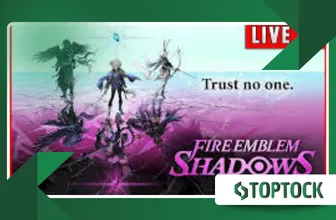Fire Emblem Shadows Is Live: Nintendo’s Social Deduction Spin-Off Hits Mobile

Fire Emblem Shadows Is Live. The core concept shifts the familiar Fire Emblem experience dramatically.
Anúncios
It retains the fantasy aesthetics and character depth, yet fundamentally alters the battlefield dynamic. This is no longer just about positioning and utilizing the weapon triangle.
A team of three players enters a real-time tactical battle against AI foes. However, one of those three is secretly a “Disciple of Shadow,” a saboteur.
The other two, “Disciples of Light,” must overcome the enemy and, crucially, identify their treacherous ally.
This mechanic infuses the game with a thrilling tension. Every move, every spell cast, and every character positioning becomes a potential sign of either cooperation or clandestine malice.
Anúncios
Is your ally intentionally mispositioning to draw enemy fire, or are they setting up a devastating counter-attack?
After the tactical phase, a mandatory voting session commences. This deduction phase is where the social game truly shines.
Arguments, accusations, and counter-arguments fly as players plead their case or try to sow discord.
Successfully identifying the Disciple of Shadow yields a beneficial buff for the subsequent battle. An incorrect vote, conversely, hands the shadow-aligned player a significant advantage.
The game subtly uses this system to leverage the psychological investment of its players.
The balance of the game is its most ambitious tightrope walk. Intelligent Systems has attempted to craft a design where battlefield performance and player communication share the spotlight.
Success demands both tactical acumen and perceptive reading of your fellow players.
Gameplay Mechanics: Real-Time Tactics Meets Treachery
Unlike the traditional, turn-based grid combat, Fire Emblem Shadows utilizes a simplified real-time tactical system.
Players set movement and attack paths for their characters but don’t have direct, moment-to-moment control.
This more hands-off approach might initially feel simplistic to veteran players.
It deliberately shifts the focus away from micro-management and toward high-level strategy and unit deployment. You focus on applying time-sensitive buffs and attacks, known as ‘Arts.’
It is here the shadow player can execute subtle acts of sabotage. For example, a Shadow Disciple might use a defensive Art on an already shielded ally, effectively wasting a crucial resource.
Conversely, they could deploy an offensive spell that, while appearing helpful, actually pulls an enemy into a more advantageous position for the AI.
The game also features two separate story modes: one following the Light Disciples, and one chronicling the Shadows.
This offers an intriguing perspective on the same overarching conflict.
Read more: Forza Horizon 6: The game has been officially announced and will be set in Japan
Playing both narratives is necessary to fully grasp the lore of the new characters and the war between the goddesses.
Market Positioning and Nintendo’s Mobile Strategy
The game’s surprise launch on September 25, 2025, in over 70 countries, was a classic “shadow drop” by Nintendo.
This release is significant as it marks Nintendo’s first wholly new mobile game since the 2019 release of Mario Kart Tour (excluding licensed titles like Pokémon).
This decision underscores a renewed focus on the highly lucrative mobile market, particularly after the immense success of Fire Emblem Heroes.
The mobile gaming market, according to a recent analysis by Data.ai, is projected to surpass $160 billion in consumer spending in 2025.
Read here: Google Play vs App Store
This makes it the dominant platform in the gaming world, a stage Nintendo clearly feels compelled to continue participating in with core IP.
By adding a popular social deduction element, they are tapping into a genre with proven viral potential, aiming for a broader, more casual audience without abandoning the franchise’s strategic roots.
For instance, consider the analogy of a high-stakes corporate boardroom meeting.
You and two colleagues are tasked with presenting a critical project, but one person secretly works for a rival firm.
The meeting’s success depends on the presentation’s content (the tactics) and your ability to detect the subtle, passive-aggressive remarks or missed deadlines caused by the saboteur (the social deduction).
In Fire Emblem Shadows Is Live, the fate of the battlefield hangs on this same volatile mix of cooperation and suspicion.
This duality is its strength and, arguably, its weakness. A game review by GameSpot noted the difficulty in making the real-time tactics feel substantial while prioritizing the deduction layer.
It’s a delicate balancing act that some early players found lacking in immediate depth. Is it possible for two distinct genres to truly merge without diluting the quality of either component?
| Element | Fire Emblem Shadows (2025) | Fire Emblem Heroes (2017) |
| Primary Genre Mix | Real-Time Tactics & Social Deduction | Turn-Based Strategy & Gacha RPG |
| Battle Type | 3-Player Co-op/VS (1 traitor) | 4v4 PvP or Single-Player Story |
| Control Style | Path-setting/Art-deployment (Semi-Automated) | Direct Unit Movement (Traditional) |
| Key Player Interaction | Deduction/Voting/Lying | Arena Battles/Friend Battles |

The Verdict on a Controversial Spin-Off Fire Emblem Shadows Is Live
The character art and overall presentation are polished, fitting the high production values expected from a Nintendo-Intelligent Systems collaboration.
New characters like Kurt and Zasha are instantly engaging, drawing players into the unique conflict between the Goddess of Light, Naga, and the Goddess of Shadow, Fenris.
This is an original story built for the mobile format.
++ MLB 9 Innings 25: Play Baseball Like a Pro with Updated Rosters
However, the game has been met with mixed early reception. One original example of a design flaw is the three-player limit for the social deduction element.
In games like Among Us, the larger player count makes for more unpredictable and chaotic deception.
Here, with a 2-versus-1 scenario, the deduction often boils down to a coin flip, or worse, relies too heavily on small, easily overlooked tactical errors.
The second original example relates to the monetization model. Being free-to-play, it incorporates in-app purchases and a “Season Pass.”
Critics argue that the power-creep associated with these systems threatens the delicate balance of the social deduction.
If one player simply pays to have significantly stronger characters, can any real deduction take place, or does the superior power inevitably betray the traitor?
This raises a crucial question about the game’s long-term integrity.
Ultimately, Fire Emblem Shadows Is Live is a bold, experimental pivot for the franchise. It challenges players to engage not just with their units, but with the minds of their allies.
Whether this risky fusion becomes a mobile phenomenon or a footnote in the series’ history remains to be seen.
It’s available now on iOS and Android for anyone ready to embrace a world where the enemy might be standing right beside you.
Frequently Asked Questions
What is Fire Emblem Shadows?
Fire Emblem Shadows Is Live is a mobile spin-off of the Fire Emblem series for iOS and Android, released on September 25, 2025.
It combines real-time tactics with a social deduction mechanic, where one of the three players in a match is a hidden traitor.
What platforms is Fire Emblem Shadows available on?
The game is exclusively available on mobile platforms: iOS (Apple App Store) and Android (Google Play Store).
Is Fire Emblem Shadows free to play?
Yes, Fire Emblem Shadows Is Live is a free-to-start game. It offers optional in-game microtransactions, including a Season Pass for premium rewards.
How does the social deduction work?
In a three-player battle, one is the ‘Disciple of Shadow’ (traitor). After the real-time tactical phase, all players vote on who they believe the traitor is.
A correct vote grants an advantage in the next battle; an incorrect vote benefits the shadow player.
Does Fire Emblem Shadows use the classic turn-based combat?
No, it utilizes a simplified real-time tactics system where players set unit paths and deploy Arts, rather than the traditional grid-based, turn-by-turn movement of the main series.
Who developed Fire Emblem Shadows?
The game was developed by Intelligent Systems in partnership with Nintendo.
++ Fire Emblem Shadows Is Nintendo’s Most Baffling Game In Year










